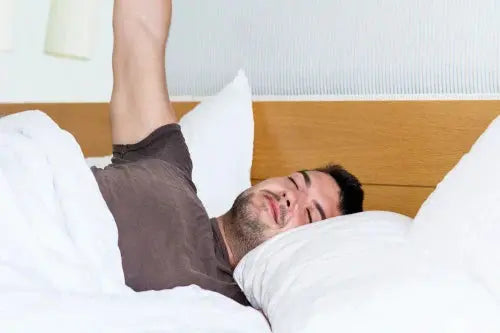
There's a key player in helping you enjoy a restful night’s sleep that’s often overlooked: carbon dioxide (CO₂).
And here’s the surprising truth: you need a healthy amount of CO₂ in your body to sleep well.
What Is Carbon Dioxide and Why Does It Matter?
Your body naturally creates the gas CO₂ when it turns food into energy. Every time you breathe out, you release some CO₂. But, when you mouth breathe or over-breathe, your body can lose too much CO₂.
Why does that matter?
CO₂ plays a key role in helping your body use oxygen properly. Without the right amount of CO₂ in your blood, oxygen can’t be released efficiently to your brain, muscles, or organs—even if you’re breathing in plenty of air.
Here’s a quick breakdown of how it works:
- You breathe in oxygen.
- Your blood carries oxygen to your brain, muscles, and organs.
- But your cells can’t actually use the oxygen properly unless there’s enough CO₂ in your blood.
This is called the Bohr Effect, and it’s the reason why over-breathing can actually reduce oxygen delivery, making you feel tired, foggy, or even anxious. It can also affect your sleep quality.
Carbon Dioxide and Sleep: What’s the Connection?
When your breathing is fast, shallow, or through the mouth, which can happen day or night, you may be losing too much CO₂.
This can lead to:
- Restless sleep
- Difficulty falling or staying asleep
- Increased nighttime awakenings
- Poor oxygen delivery to the brain
- Hyperarousal (your nervous system stays "on" when it should be resting)
But when you breathe lightly, slowly, and through your nose, your CO₂ levels are better balanced. And that’s where the magic happens:
- Your nervous system relaxes
- Your breathing becomes quieter and more stable
- Oxygen delivery improves
- You fall asleep faster and stay asleep longer
How to Support Healthy CO₂ Levels for Better Sleep
The key to building up CO₂ tolerance is to breathe less, not more. That means:
- Nasal breathing (in and out through the nose, even during sleep)
- Exercises to promote light, slow, and deep breathing
These habits help your body get used to slightly higher CO₂ levels, which is a good thing.
Tip: It’s normal to feel a little “air hunger” at first when you begin these exercises. This gets easier with consistent practice, as your breathing becomes more efficient, your nervous system stays calmer, and your sleep quality improves.
Practice the Breathe Light Exercise
This core Buteyko Method exercise improves CO₂ tolerance, so you can breathe more lightly and calmly, even during sleep.
How to do it:
- Sit or lie comfortably in bed.
- Gently close your mouth and breathe in and out through your nose.
- Take smaller, quieter breaths—almost as if you’re breathing less than normal.
- Focus on making each breath light, slow, and controlled.
- Continue for 3–5 minutes or until you feel relaxed and sleepy.
Goal: Practice 5 minutes, 4–6 times a day, and a full 10 minutes before bed.
🎧 Click here to practice the Breathe Light Exercise guided audio session.
Aim for a Control Pause Score of 20+ seconds
Want to know how your breathing is doing? The Control Pause test gives you a quick snapshot of your breathing efficiency and CO₂ tolerance.
How to Do the Control Pause Test:
- Sit down comfortably and breathe normally for a minute or so.
- Take a small, normal breath in (not a big inhale), then a small breath out.
- Hold your breath after the exhale and start a timer.
- Stop the timer as soon as you feel the first urge to breathe, this could be a slight movement in your throat, or a twitch in your diaphragm.
- Breathe in gently through your nose and return to normal breathing.
Your Control Pause score is the number of seconds you can comfortably hold your breath after a normal exhale.
A Control Pause score of 20 seconds or more is a sign of calmer breathing and better balance. As you practice slow, nasal breathing, your Control Pause will go up, and so will your sleep quality.
Final Thoughts
Your body needs CO₂ to breathe efficiently, sleep deeply, and stay calm.
By practicing nasal, light breathing and building your CO₂ tolerance, you can transform the way you sleep, naturally and gently.
Want to get started? Try the Breathe Light Exercise or check out our other guided breathing audios.
Want to learn more? [Discover The Breathing Cure for Better Sleep by Patrick McKeown →]
